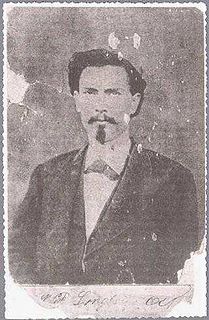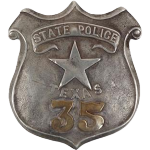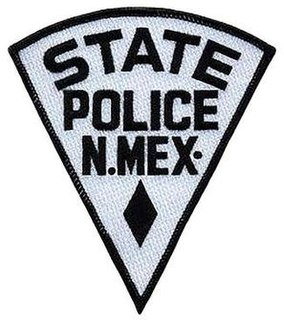Related Research Articles

James Butler Hickok, better known as "Wild Bill" Hickok, was a folk hero of the American Old West known for his work across the frontier as a drover, wagon master, soldier, spy, scout, lawman, gunfighter, gambler, showman, and actor. He earned a great deal of notoriety in his own time, much of it bolstered by the many outlandish and often fabricated tales that he told about his life. Some contemporaneous reports of his exploits are known to be fictitious, but they remain the basis of much of his fame and reputation, along with his own stories.

The Texas Ranger Division, commonly called the Texas Rangers and also known as "Los Diablos Tejanos"—"the Texas Devils", is a U.S. statewide investigative law enforcement agency with statewide jurisdiction in Texas, based in the capital city of Austin. Over the years, the Texas Rangers have investigated crimes ranging from murder to political corruption, acted in riot control and as detectives, protected the governor of Texas, tracked down fugitives, and functioned as a paramilitary force at the service of both the Republic (1836–1845) and the state of Texas.

The Bureau of Refugees, Freedmen, and Abandoned Lands, usually referred to as simply the Freedmen's Bureau, was a U.S. government agency from 1865 to 1872, after the Civil War, to direct "provisions, clothing, and fuel ... for the immediate and temporary shelter and supply of destitute and suffering refugees and freedmen and their wives and children."
George Scarborough was a cowboy and lawman who lived during the time of the Wild West. He is best known for having killed outlaw John Selman, killer of John Wesley Hardin, and for his partnership with lawman Jeff Milton, with the pair bringing down several outlaws during their time together.

John Wesley Hardin was an American Old West outlaw, gunfighter, and controversial folk icon. The son of a Methodist preacher, Hardin got into trouble with the law from an early age. He killed his first man at age 15; he claimed it was in self-defense.

The 5th Military District of the U.S. Army was a temporary administrative unit of the U.S. War Department that existed in the American South. The district was stipulated by the Reconstruction Acts during the Reconstruction period following the American Civil War. It included Texas, from Brazos Santiago Harbor,, at the Mexican border, north to Louisiana. General Philip Sheridan served as its first military governor, until removed by U.S. President Andrew Johnson because of a charge of excessive harshness in Sheridan's treatment of former Confederate soldiers. He was replaced by Charles Griffin, then by Joseph J. Reynolds.
Special police usually describes a police force or unit within a police force whose duties and responsibilities are significantly different from other forces in the same country or from other police in the same force, although there is no consistent international definition. A special constable, in most cases, is not a member of a special police force (SPF); in countries in the Commonwealth of Nations and often elsewhere, a special constable is a voluntary or part-time member of a national or local police force or a person involved in law enforcement who is not a police officer but has some of the powers of a police officer.
Southwestern University is a private university in Georgetown, Texas. Formed in 1873 from a revival of collegiate charters granted in 1840, Southwestern is the oldest university in Texas. Southwestern offers 40 bachelor's degrees in the arts, sciences, fine arts, and music as well as interdisciplinary and pre-professional programs. The university is accredited by the Southern Association of Colleges and Schools and the National Association of Schools of Music. It is historically affiliated with the United Methodist Church.

William Preston Longley, also known as Wild Bill Longley, was an American Old West outlaw and gunfighter noted for his ruthless nature, speed with a gun, quick temper, and unpredictable demeanor. He is considered to have been one of the deadliest gunfighters in the Old West.

The Texas State Police (TSP) was created following the Civil War by order of Texas Governor Edmund J. Davis. The TSP worked primarily against racially based crimes in Texas, and included black police officers. It was replaced by a renewed Texas Rangers force in 1873.

The Fort Worth Police Department is the police department of Fort Worth, Texas, United States. Ed Kraus is the Chief of Police.

John Selman was sometimes identified as an outlaw and sometimes a working lawman of the Old West. He is best known as the man who shot John Wesley Hardin in the Acme Saloon in El Paso, Texas, on August 19, 1895.

Ben Thompson was a gunman, gambler, and sometimes lawman of the Old West. He was a contemporary of "Buffalo" Bill Cody, Bat Masterson, John Wesley Hardin, and "Wild Bill" Hickock, some of whom considered him a friend, others an enemy. Thompson fought for the Confederacy during the Civil War, and later for Emperor Maximilian in Mexico. When hired in 1881 as marshal in Austin, Texas, the crime rate reportedly dropped sharply. Thompson was murdered at the age of 40 in San Antonio, Texas, in the "Vaudeville Theater Ambush."

The New Mexico State Police is the state police agency for New Mexico, which has jurisdiction anywhere in the state. It was created to protect the lives, property and constitutional rights of people in New Mexico. The State Police is a division within the New Mexico Department of Public Safety.

This is a selected bibliography of the main scholarly books and articles of Reconstruction, the period after the American Civil War, 1863–1877.
The Horrell brothers, sometimes referred to as the lawless Horrell boys, were five brothers from the Horrell family of Lampasas County, Texas, who were outlaws of the Old West, and who committed numerous murders over a five-year period before four of the brothers were killed in different incidents. The brothers are probably best known for the Horrell-Higgins feud, although it resulted in relatively few deaths compared to other feuds. However, starting in 1873, the brothers went on an ethnically motivated killing spree during which they killed a Hispanic lawman and a white lawman in New Mexico, killed 11 other Hispanic men, and wounded one Hispanic woman. The brothers had previously killed five lawmen in Texas.

Feuds in the United States deals with the phenomena of historic blood feuding in America. These feuds have been numerous and some became quite vicious. Often, a conflict which may have started out as a rivalry between two individuals or families became further escalated into a clan-wide feud or a range war, involving dozens—or even hundreds—of participants. Below are listed some of the most notable blood feuds in United States history, most of which occurred in the Old West.
The Sutton–Taylor feud began as a county law enforcement issue between relatives of Texas state law agent, Creed Taylor, and a local law enforcement officer, William Sutton, in DeWitt County, Texas. The feud cost at least 35 lives and eventually included the outlaw John Wesley Hardin as one of its participants. It started in March 1868, not reaching its conclusion until the Texas Rangers put a stop to the fighting in December 1876.
John Jackson "Jack" Helm, was a lawman, cowboy, gunfighter, and inventor in the American Old West. He fought for the Confederacy during the Civil War, but worked as a lawmen for the Union during Reconstruction. He was an active participant in the Sutton–Taylor feud in and about Dewitt County, Texas; and was killed in an ambush related to the feud and perpetrated by Jim Taylor and John Wesley Hardin.
Albuquerque, Texas was a settlement established in 1857 by Samuel McCracken and Henry Hastings. Its population grew, and following the American Civil War, the town boasted a mercantile store, saloon, blacksmith shop, cotton gin, and an elementary school. Its U.S. post office opened in 1870. Albuquerque, Texas is today a ghost town.
References
- 1 2 3 The Governor's Hounds The Texas State Police, 1870–1873 By Barry A. Crouch and Donaly E. Brice, University of Texas Press; Reprint edition (December 1, 2012), ISBN 0292747705 and ISBN 978-0292747708
- ↑ Ann Patton Baenziger, "The Texas State Police during Reconstruction: A Reexamination," Southwestern Historical Quarterly 72 (April 1969)
- 1 2 3 Ann Patton Baenziger, "The Texas State Police during Reconstruction: A Reexamination," Southwestern Historical Quarterly 72 (April 1969)
- ↑ State Police; Johnson, John G.; June 15, 2010; article; "The Texas Handbook" online; Texas State Historical Association; accessed April 09, 2015.
- ↑ "Special Police Officer Green Paramore". The Officer Down Memorial Page (ODMP). Retrieved 12 April 2015.
- ↑ http://www.odmp.org/officer/19654-special-police-officer-green-paramore